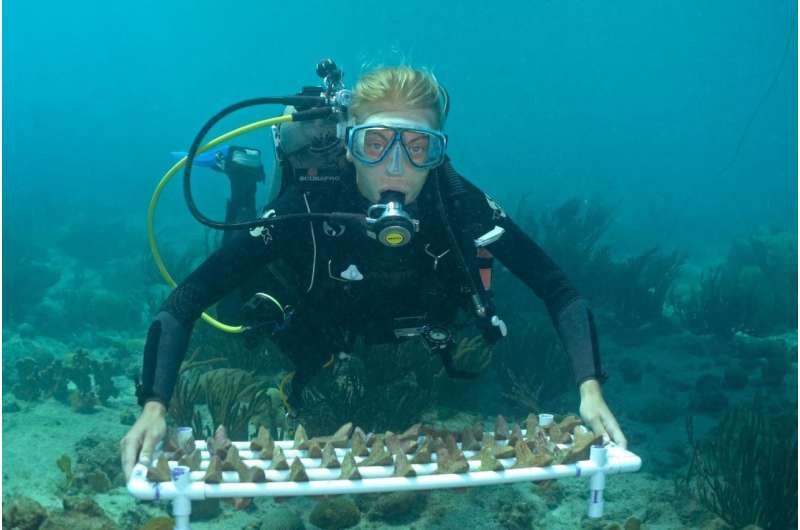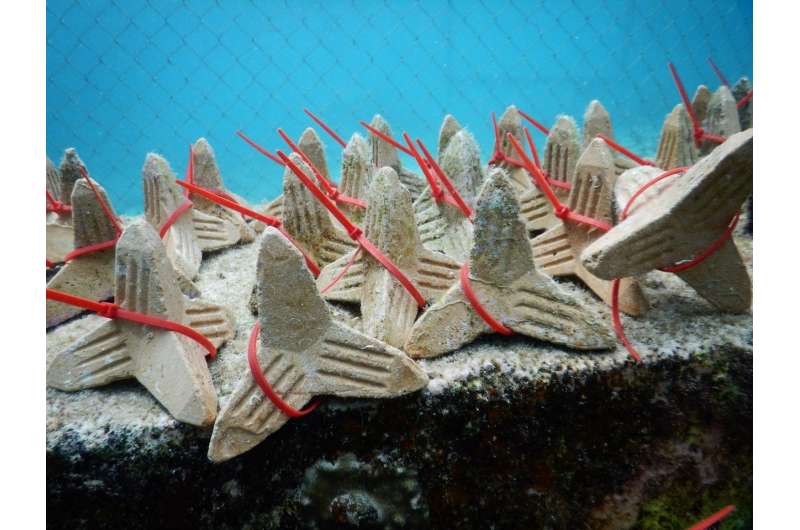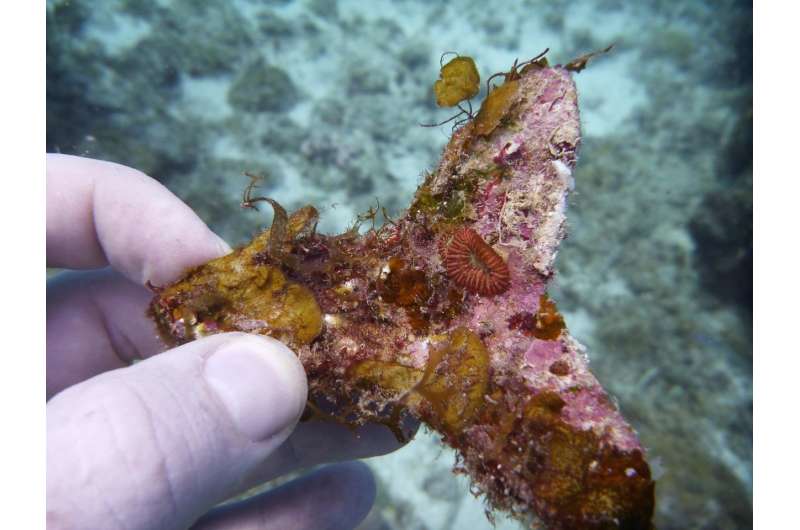Sowing corals: A new approach paves the way for large-scale coral reef restoration

The troubling loss of coral reefs worldwide has prompted scientists and conservationists to assist the reefs' recovery through active restoration approaches. Transplanting corals on degraded reefs aims at increasing coral cover and subsequently promoting structural habitats. Until now, actual restoration has been done manually by divers, who had to attach each coral, whether a fragment or a coral recruit settled on a substrate, individually.
Today, reef degradation occurs at a scale of hundreds and thousands of square kilometers. In contrast, current restoration activities are usually less than one hectare in scale. These efforts are limited by the fact that only labor-intensive, and therefore costly, techniques are currently available. "If we want restoration to play a more meaningful role in coral reef conservation, we need to think in new directions. Our sowing approach is an important step towards reaching this goal since it will allow the handling of large numbers of corals in a very short amount of time at significantly lower costs", says Dr. Dirk Petersen, project lead and Executive Director of SECORE International.
In the sowing approach, coral larvae are settled on specifically designed substrates that are self-stabilized and attach to the reef via natural processes. After a few weeks to months these so-called "Seeding Units" (i.e., substrates together with initial coral polyps) are sown on the reef by simply wedging them in crevices rather than requiring manual attachment. Until today, transplanting for instance 10,000 individual corals on one hectare using common methods requires several hundred to a few thousand person-hours. "Sowing the same number of corals could be achieved in less than 50 person-hours, a time saving of over 90 percent. Additionally, material costs could be reduced up to one third, representing a substantial advance for future restoration work", says SECORE's Research Director Dr. Margaret Miller.
Sexual coral reproduction and genetic diversity
On Curaçao, the team collected larvae released by colonies of golf ball corals (Favia fragum). "Shortly after collection, we settled the coral larvae on specially designed tetrapod-shaped substrates made of cement", explains Valérie Chamberland, who led the field research for this study on Curaçao.

Working with sexually propagated corals maintains genetic diversity. Different gene combinations, so-called genotypes, arise within the population by recombination - the reshuffling of the genetic characteristics of parents among their offspring. New genetic combinations may then equip some coral offspring with capabilities to better cope with today's and future conditions than their struggling parents. "This is of vital importance for any coral species in the face of climate change. In this way, we may get corals that for example are more resilient to raising water temperatures", says Dirk Petersen.
Three weeks later the settled coral larvae had turned into initial coral polyps and the units were sown on the reef in front of the Curaçao Sea Aquarium. "The specific shape of the tetrapod substrates allowed us to simply wedge the Seeding Units into natural crevices of the reef. Most Seeding Units were stable within few weeks, either secured in crevices or naturally cemented on the reef's framework", says Valérie Chamberland.
The design of the substrates not only promotes the attachment on the reef, but is also intended to enhance the survival of the coral settlers. "The different orientations of the Seeding Units' surfaces and their integrated grooves create micro-habitats that likely reduce competition and predation affecting the young and very fragile corals compared to when larvae settle directly on the reef. This is crucial, as our results show that the early post-settlement life stage is the bottleneck for the survival of young corals", says Dirk Petersen.
In the twelve months following the sowing, the scientists closely monitored substrate attachment to the reef and the survival rates of coral settlers. "We settled between 20-30 larvae on each substrate to ideally have one coral established per Seeding Unit in the long term. After one year more than half of the units were recovered and still harbored at least one coral, meeting this target required to eventually yield a successful restoration outcome", explains Valerie Chamberland.

Advancing the sowing approach
SECORE scientists are now optimizing the substrate design to further increase coral settler survival and growth. "While the substrates were initially colonized by friendly crustose coralline algae communities that facilitate larval settlement and metamorphosis, their light-exposed upper surfaces became rapidly overgrown by competing algal turfs once put on the reef. This likely contributed to a relatively high mortality of coral settlers during the first three months on the reef", says Valerie Chamberland. As preliminary experiments suggest, substrates of non-porous materials such as glass or glazed ceramics could deter the formation of turf algae communities and further enhance survival and growth of settled corals.
So far, sowing settled corals was tested in a research pilot - now it needs to be tested on a much larger scale. The processing of 50,000 to 100,000 substrates within a single location and spawning season will involve major logistical and engineering challenges. Together with the California Academy of Sciences, The Nature Conservancy, and other partners, SECORE plans to overcome these challenges in the course of the recently launched Global Coral Restoration Project.
"We are routinely able to produce one million larvae from a single spawning event. Until now, the number of substrates was limited as they were produced manually using moulds. We are currently working together with our partners to implement industrial manufacture of the tetrapod substrates in large numbers at significantly lower costs", says Dirk Petersen. "If we are able to combine our new sowing approach with more effective coral larvae rearing techniques, which we are developing right now, costs of reef restoration could become comparable to the costs of existing mangrove and salt marsh restoration efforts."
SECORE and partners are working together to refine each step of the sowing approach. This also includes the development of different shapes of Seeding Units to cover a wide range of reef habitats and optimizing post-settlement survival of the very small initial life stages across a wider range of species. One day, it may be possible to sow corals from a boat or with underwater drones.
More information: Valérie F. Chamberland et al, New Seeding Approach Reduces Costs and Time to Outplant Sexually Propagated Corals for Reef Restoration, Scientific Reports (2017). DOI: 10.1038/s41598-017-17555-z
Journal information: Scientific Reports
Provided by SECORE international



















